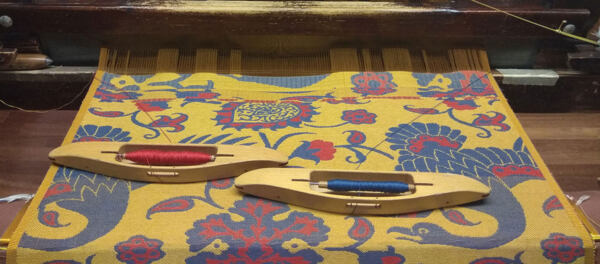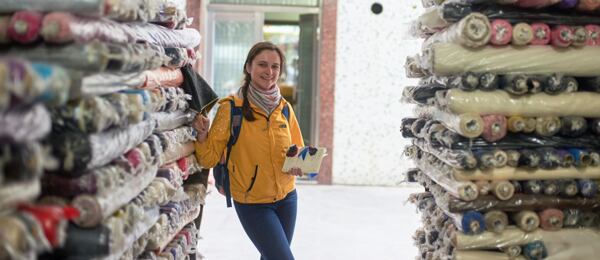

Marcela “I studied construction in school, believe it or not… a field where you only run into textiles in a technical context. After graduation I set off for China as a building site supervisor with a German company. It was supposed to be a short assignment at first, but as so often happens, it turned into several years. My kid sister Zuzka was still in high school at the time, and busy with her own interests.”

Zuzka “In high school I was crazy about history and handcrafts. Since I could sew, I made my friends historical and made-up costumes. With Marcela in China, the cradle of the silk trade, I thought I’d ask whether she could find me some nice fabrics. She turned up with a whole sack-full from a market in Beijing. I thought I might try selling what I didn’t use. A friend built me a barebones e-shop and I unloaded the contents of the sack into a closet in my parent’s house and started touring medieval re-enactments with my wares. I dubbed my shop Sartor. It’s Latin for ‘tailor’ and pops up in English and the Romance languages.”

Marcela “I knew they make all kinds of fabric in China. The textile market there is like an exciting – and frankly intimidating – labyrinth where you can find unbelievable treasures if you know where to look. In Shanghai I used to go to a huge covered market with lots of fabric stalls and tailors, and I’d send my finds back in 15 kilo bags to the Czech Republic. I gradually fell in love with the textile industry; it’s basically a technical field, after all. An acquaintance got me into some textile expos. I snooped around in one of the shops for information about where to find silk resellers. At that point I was only familiar with the expensive boutiques in downtown Shanghai, where prices are inflated because of tourists. When I finally returned home and went to see my folks, I got a serious talking-to.”

Zuzka “I had begun college, but was still running Sartor. Mom helped with cutting and sending material, because she knew that otherwise I wouldn’t have any time left for my studies. The house was bursting with fabric. When Marcela came home, Mom and Dad turned to her, as the older and wiser one, to have a talk with me to explain that it couldn’t go on like this. It was obvious that we’d have to give the whole thing up or else really, seriously commit to it. Guess how we decided… in the end we actually did get around to making that business plan and then found a space and hired our first employees. Marcela came up with the storefront downtown Prague and we both dove into learning everything we could, hunting down new suppliers, and expanding our selection.”
Neither of us was prepared to run a business so we learned almost everything on the fly. We had to study up on lots of pretty dreary necessities and overcome numerous obstacles (if there were only a way without lawyers or accounting). Going into business for yourself is interesting and exhilarating, but sometimes it can also be very intense, which tested not only the two of us individually, but also our relationship as sisters and the good will of our partners and children.
Our reward, however, is a company that we genuinely love and that we really enjoy improving and taking forward. One thing that remains from those magical times at the beginning – something we hope will never leave – is a love for beautiful fabrics, quality products, craft, and tradition. We are even happier that Sartor seems to naturally attract customers that share these values. We’ve known some of you a good long time, some just a short while, but altogether and without exception, we make up a great community, bound by an interest in extraordinary materials and the art of sewing.

By the way, if you want to know what it takes at Sartor just to “expand our selection,” it’s one of the most demanding, but most beautiful, parts of our work. We continue to travel regularly to the East, mostly to China and India, where we personally meet our suppliers, search for good weavers and manufacturers, learn something about the local lifestyle and crafts, and cast around for new opportunities and inspiration. You can follow us on our travels through our blog.
We also travel in the other direction, to the West, this time as silk merchants. We’ve come to be known as “the silk ladies” in the United States, and customers tell us we bring them not just goods, but new observations and information. We are not a large company and we have no desire to become one, but we do like the idea that we’re treading our own silk road across many continents.



Comments(0)